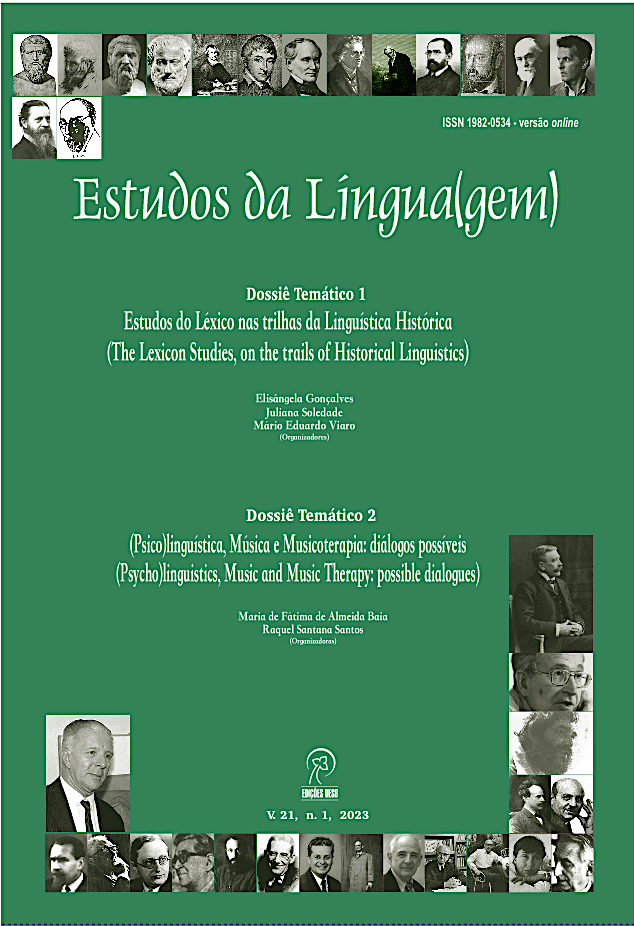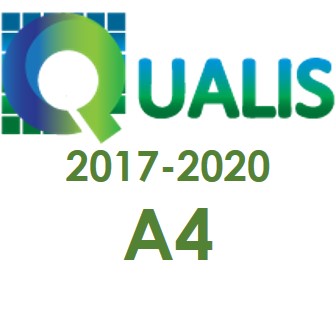Word and music: a glance at the common ancestor
DOI:
https://doi.org/10.22481/el.v21i1.13375Keywords:
Spoken language; Music; Natural communicative processes; Communicative Musicality; Intuitive Parenting.Abstract
This text, written as an essay, presents a theoretical reflection about the possible common origins of word and music. Starting from recent studies about the communication processes in the animal and vegetal kingdoms, the text goes through a discussion about the evolution of communication among vertebrates, some concepts from Cognitive Archeology, to arrive finally at Homo sapiens. Next, the communication between adults and babies is discussed, that moment before the child enters the world of symbols – the world of words – and the concepts of Intuitive Parenting and Communicative Musicality are presented. The text ends with a reflection on the "musical" as one of the founders of human life.
Downloads
References
COCCIA, E. A vida das plantas – uma metafísica da mistura. Florianópolis: Editora Cultura e Barbárie, 2018.
DISSANAYAKE, E. Homo musicus: are humans predisposed to be musical? Annais do X Encontro de ciências cognitivas da música. Sociedad Argentina para las Ciencias Cognitivas de la Música (SACCoM), 2011. Disponível em http://saccom.org.ar/v2016/sites/default/files/1.Dissanayake.pdf Acesso em: 8 de agosto de 2022.
DISSANAYAKE, E. Root, leaf, blossom, or bole: concerning the origin and adaptive function of music. In: MALLOCH, S.; TREVARTHEN, C. (Org). Communicative Musicality. New York: Oxford University Press, 2009. p. 17-30.
FONSECA, J. G. M.; PARIZZI, B. A música (muito) além da música. Pista: Periódico Interdisciplinar. Belo Horizonte, v.2, n.1, p. 38-46, fev./jun. 2020.
GIL, J. O Espaço interior. Lisboa: Editorial Presença, 1993.
JANIK, V.M., SAYIGH, L.S., WELLS, R.S.: Signature whistle shape conveys identity information to bottlenose dolphins. PNAS, v.1 03, issue 21, p. 8293-8297, May 23, 2006. Disponível em https://doi.org/10.1073/pnas.0509918103. Acesso em: 10 de janeiro de 2022.
MALLOCH, S.; TREVARTHEN, C. The Human Nature of Music. Malloch, Stephen N. and C. Trevarthen. “The Human Nature of Music.” Frontiers in Psychology, v. 9, 2018. Disponível em https://pubmed.ncbi.nlm.nih.gov/30337892/. Acesso em: 22 de maio de 2021. https://doi.org/10.3389/fpsyg.2018.01680
MALLOCH, S.; TREVARTHEN, C. Musicality: Communicating the vitality and interests in life. In: MALLOCH, S.; TREVARTHEN, C. (Org). Communicative Musicality. New York: Oxford University Press, 2009. p. 1-11.
MANCUSO, S. A planta do Mundo. São Paulo: Ubu Editora, 2021.
MELGAÇO, R. G. Prefácio. In: BUSNEL, M. C.; MELGAÇO, R. G. (Org). O bebê e as palavras: uma visão transdisciplinar sobre o bebê. São Paulo: Editora Instituto Langage, 2013. p.11-12.
MITHEN, S. The Music instinct: the evolutionary basis of musicality. The evolutionary basis of musicality. Annals of the New York Academy of Sciences, v. 1169, p. 3-12, 2009. doi: 10.1111/j.1749-6632.2009.04590. x. 2009.
OLIVEIRA J. C.; AMOROSO M.; LIMA A. G.M.; SHIRATORI K.; MARRAS, S.; EMPERAIRE, K. Vozes vegetais: diversidade, resistência e histórias da floresta. São Paulo: Ubu Editora, 2021.
PAPOUSEK, M. Intuitive parenting: a hidden source of musical stimulation in infancy. In: DELIÉGE I.; SLOBODA J. (Ed.) Musical beginnings. New York: Oxford University Press, 1996, cap. 4, p. 88-112.
PARIZZI, M.B. O desenvolvimento da percepção do tempo em crianças de dois a seis anos: um estudo a partir do canto espontâneo. Tese de Doutorado. Faculdade de Medicina da Universidade Federal de Minas Gerais, 2009.
PARLATO-OLIVEIRA, E. Saberes do bebê. São Paulo: Editora Instituto Langage, 2019.
RODRIGUEZ, M.R. Vocalizations. The Prairie dog Project. 2018. Disponível em https://www.prairiedoghoogland.com/vocalizations. Acesso em: 10 de janeiro de 2022.
SANTO AGOSTINHO. A doutrina cristã: manual de exegese e formação cristã. São Paulo: Editora Paulus, 2002.
SAVAGE, P. E., LOUI, P., TARR, B., SCHACHNER, A., GLOWACKI, L., MITHEN, S., FITCH, W. T. Music as a coevolved system for social bonding. Behavioral and Brain Sciences, 2020. Disponível em https://doi.org/10.1017/S0140525X20000333. Acesso em: 20 de setembro de 2021.
SHIFRES, F. La ejecución parental: los componentes performativos de las interaciones tempranas. Anais do VI encontro da SACCOM: Universidade de la Plata, Argentina, 2007. p.13-17, 2007.
TREVARTHEN, C.; AITKEN, K.; GRATIER, M. O bebê nosso professor. São Paulo: Editora Instituto Langage, 2019.
Downloads
Published
How to Cite
Issue
Section
License

This work is licensed under a Creative Commons Attribution 4.0 International License.

Estudos da Língua(gem) is licensed under a Creative Commons Attribution 4.0 International License.
Authors who publish in the journal Estudos da Língua (gem) agree with the following terms:
The journal Estudos de Língua(gem) maintains the copyrights of the contributions published. These rights include the publication of the contribution and make its content available for free through the portal.







